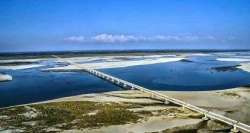Interesting facts about Dhola-Sadiya, India's longest bridge
It is 3.55 km longer than Mumbai's Bandra-Worli sea link, making it the longest bridge in India.

India's longest river bridge, capable of withstanding the weight of a 60-tonne battle tank, will be inaugurated in Assam close to the border with China on May 26 by Prime Minister Narendra Modi.
Named Dhola-Sadiya, this bridge will break many records held earlier.
These are some interesting facts about the gigantic structure:
It is 3.55 km longer than the Bandra-Worli sea link in Mumbai, making it the longest bridge in India.
The bridge can withstand the movement of military tanks.
Dhola-Sadiya bridge is 9.15-km-long and spans the Lohit River to connect the states of Assam and Arunachal Pradesh.
India will shore up its defence requirements along the Sino-Indian border, particularly in the northeast by this bridge.
The bridge will help provide easy access to the people of Arunachal Pradesh and Assam with air and rail connectivity.
The construction of the bridge began in 2011 at a project cost of Rs. 950 crore.
The bridge is located 540-km away from Assam's capital Dispur and 300 km away from Arunachal Pradesh's capital Itanagar. The aerial distance to the Chinese border is less than 100 km.
The bridge, when opened for the public, will cut down the travel time between Assam and Arunachal Pradesh by as much as four hours.
As there is no civilian airport in Arunachal Pradesh, this bridge will help people of the state to reach the nearest rail head in Tinsukia and the airport in Dibrugarh easily.
After Kaliabhomora bridge near Tezpur, there is no bridge over the Brahmaputra for the next 375 km upstream till Dhola, where the new bridge is constructed. Currently, all transportation between the river's two banks is carried out through water only.
The bridge is one of the key projects of the Ministry of Road Transport and Highways in the Northeast and is built in public-private partnership with a construction company.
Also Read: World's highest rail bridge on River Chenab